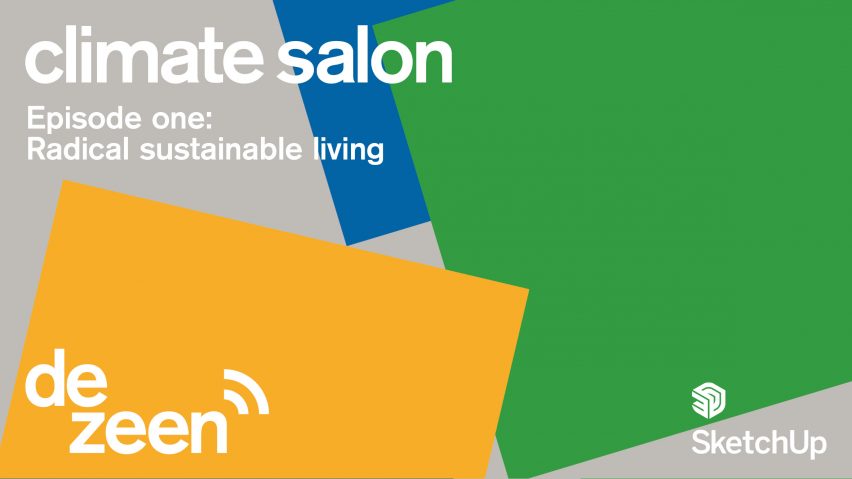A panel spanning design, architecture and technology stressed that building and living more sustainably requires a universal approach in the first episode of our new Climate Salon podcast series with SketchUp.
Listen to the episode below or subscribe on Apple Podcasts, Spotify and Google Podcasts to catch the whole series.
In the launch episode titled Radical Sustainable Living, designer Tom Dixon, Siv Helene Stangeland, founder of Norwegian architecture firm Helen & Hard, and design software company SketchUp's Sumele Adelana discussed the importance of working across industries and disciplines to reduce the environmental impact of building and designing for homes.
Speaking to Jennifer Hahn, host of the podcast series and Dezeen's design and environment editor, the panel concurred that effecting serious change requires a united front between design disciplines as well as across consumers, clients and localities.
"It requires enlightenment from everybody for the thing to work," said Dixon. "A universal attitude is what is needed. We need a United Nations of climatology."
Dixon proposed that a more collaborative approach would be driven by changes in legislation or socioeconomic circumstances. "Change will not happen until people are forced to act collectively," he said.
Adelana, architectural designer and product specialist at SketchUp, agreed, emphasising the power that local administrators hold.
"There is a lot more work that needs to be done to push a collective effort, right through from legislation on the global level, and the national level, and however deep you want to go," she said.
"The local boroughs have a huge part to play because they own building stock, they influence the work that happens in their boroughs."
The conversation is the first episode of Dezeen and SketchUp's Climate Salon, a new podcast exploring the role that architects and designers can play in tackling climate change.
Across six episodes, Dezeen will speak to architects, designers and engineers to explore how to better collaborate across their respective disciplines to create a more cohesive response to climate change.
The first episode is now available to download in advance of Milan design week. Subscribe now on Spotify, Apple Podcasts or Google Podcasts to make sure you don't miss an episode.
Leading from the top
In the first episode, the panel touched on topics including the role of designers in educating consumers and clients on the potentials of more sustainable materials, how co-living could offer a more sustainable model for housing people, and the continued importance of upholding the basic principles of designing long-lasting and appealing homes and products.
The panel agreed that sustainable practices need to be championed by leadership, whether within architecture practices or in government.
Describing the situation within architecture practices, Adelana stated: "if there are no champions right at the top, then the team that works within these practices either has to be highly interested in delivering sustainability, so that they do it as an add on to the work that is already required of them, or it just doesn't happen at all."
Stangeland emphasised that changes in industry practices should be bolstered by political change.
"The building industry is embedded in systems that are stuck with old ways of doing things," she said. "If we are going to change systems, we also need to have help from from governments. You can't expect designers to do that job, it's a collective effort."
Importance of good design
Stangeland described how designing homes that people want to live will encourage a longer lifespan, leading to less resource and energy consumption.
"The best way of making something last is that we make something of value, and people want to take care of it," she said.
Dixon added that "the best things you can do is make things not fashionable, make things that people will be able to reuse."
"You can build things in a more durable way and then find economic models where people can share them, or lease them or pass them around a bit more," he continued.
Alternative ways of living
The panel also discussed the ways in which buildings can be designed to encourage inhabitants to make more sustainable choices in their day-to-day lives.
Stangeland is a board member of Norwegian co-living developer Gaining by Sharing, and lives in its Vindmøllebakken community, which was designed by Helen & Hard.
"If we can live on a smaller footprint by sharing space and things and services, it will have a big impact," she said.
"[The success and popularity of the project] is proving that people are also willing to change quite a lot if they know that this is really making an impact."
"Instead of feeling that you are reducing something to cope with climate action, people are in fact feeling that they gained something because living in a community is really a rich and life full of opportunities and possibilities."
Each hour-long episode of the Climate Salon podcast will provide insight into how specialists across diverse disciplines can work in conjunction to mitigate the effects of climate change.
The series will also explore the role that technology can play in cutting down emissions, focussing on tools that are readily available to designers and engineers today.
Future episodes will explore topics like regenerative architecture, integrating nature into design processes, how designing for inclusivity is related to sustainability, and the potential of new green technologies.
Produced by Dezeen's in-house creative team, Climate Salon episodes will be released over the coming months along with opinion pieces by SketchUp relating to the topics featured in the series.
SketchUp is a piece of 3D design software used to model architectural and interior design projects, product designs, civil and mechanical engineering and more.
Partnership content
The Climate Salon podcast is produced by Dezeen in partnership with SketchUp. Find out more about Dezeen partnership content here.

